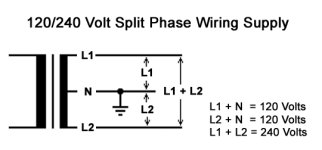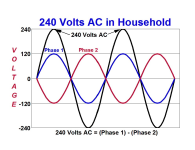Not all RV's have that equipment.
AZCLAN answered confirming my posts info.
"The half round or U is the ground the one directly below it is the WHITE or neutral and the other two black wires are 180 degrees out of phase with each other are the HOT 120-volt. In reality you have TWO 120 volt split service going into your RV."
(this is exactly what I have been posting about for several days now and this is not the same as a standard 220/240 volt circuit which has two 120v in single phase)
This quote (bold face) from myrv.us makes no sense at all (true)"Almost ALL 50-amp wired RV's use both sides of the service separately as 120 volt on each leg. (False)Only a few mostly high-end coaches utilize the 240-volt from this same service. There is no way to get 240 from a standard double 120v camper circuit without rewiring the circuit at the breaker. NO campground is going to let you do that. However, I suppose that the RV might have an on board transformer that could take the two 120v circuits input and boost them to 240 to use the power.
Now I broke my self promise not to post on this any more.
You are reading my post incorrectly. On the line coming into a house you have 2 Hot wires (L1 and L2 in the diagram below), a Neutral (N in the diagram below) and a Ground (represented as a downward pointing segmented arrow in the diagram below).
L1 to L2 is 240V
L1 OR L2 to N is 120V as the neutral splits the difference between the two sides of the 240V wires (hence the term "split phase", it splits the single phase in half).
Here is a diagram showing that from RVTech:
Source:
Electrical Tutorial - Chapter 3 - 3 Amp versus 5 Amp
Note that the picture above shows the feed up to the main breaker, after that the Ground and the Neutral are separated.
are you claiming the 2 hots are the same leg for an RV????
If that was the case, the neutral would have to carry twice the current of the hots. You would need something like 4 ga for the neutral and 6ga for the hots. Why would anyone do that? that is a whole bunch of wasted copper for no gain and the loss of the option of ever using 240v. What would possibly be gained by doing it that way?
Good point.
A 30 amp RV plug is 30 amps of 120V (from one L1 or L2 to N), it has a Hot, a Neutral and a Ground.
A 50 amp RV plug is 50 amps of 240V (from L1 to L2), it has 2 Hots (L1 & L2), a Neutral (N) and a Ground (G). Because it is a 4 wire plug, you also get 120V when you go from L1 to N.
As a result, you can get 100 amps of 120V out of a 50 amp 4 wire plug.
In line with what Groo said, with a 50A 4 wire 240V connection, if you put 30 amps on L1 and 20 on L2 (for a total of 50 amps), the Neutral (N) is only carrying 10 amps as the L1 and L2 balance each other out, when L1 is at +120V (compared to N), the L2 is at -120V (compared to N) and they swap places 60 time per second (in the US and most of Canada).
If you want to test this, test the plug with a multimeter as shown in the video that justinramani linked to:
Multi-Meter Test 5 Amps - YouTube Start at about 2:00 for him showing 240V at a 50 amp receptacle.
RVEducation 101 has an excellent video showing this as well:
Aaron Z

